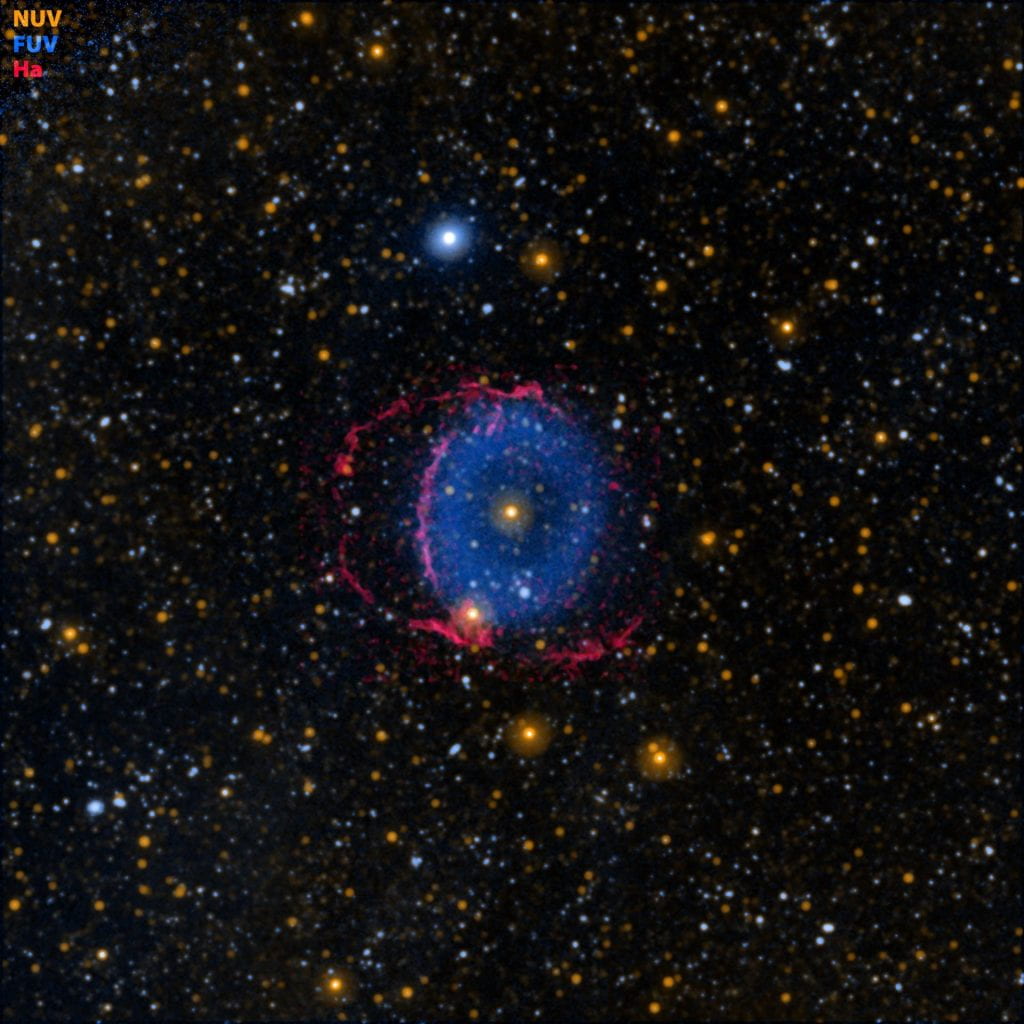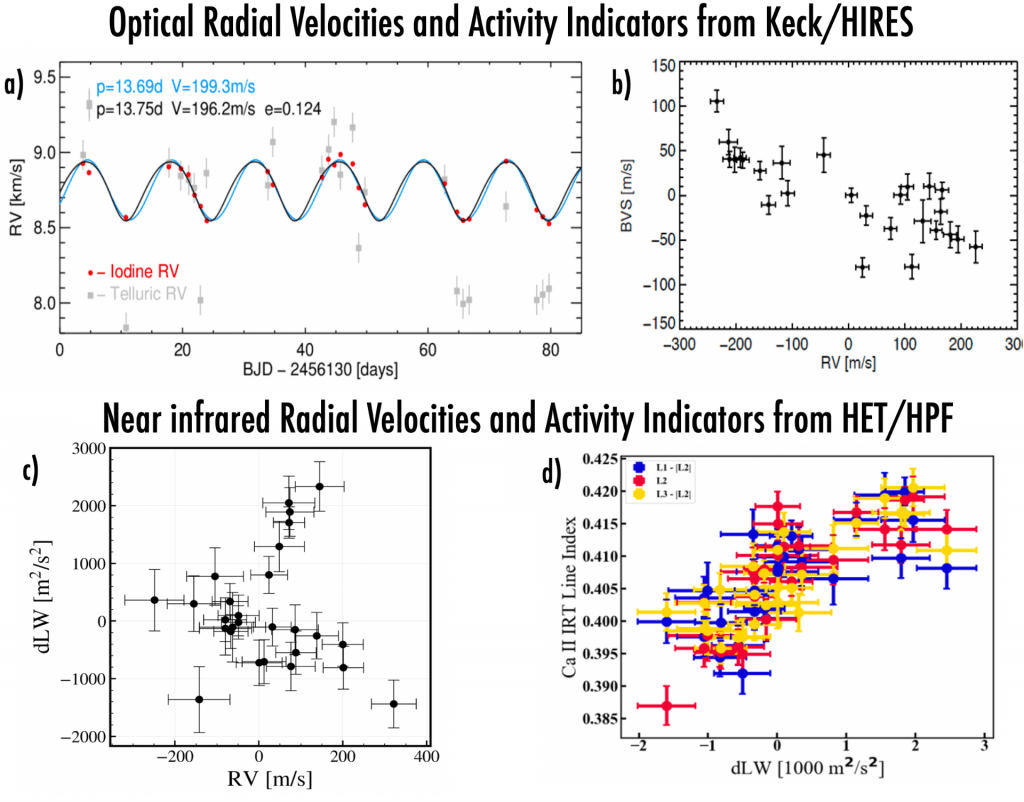The Blue Ring Nebula is a rare and peculiar object composed of gas expanding from a central star, and is the subject of the most recent paper involving data from HPF. The Blue Ring Nebula (Figure 1) was originally discovered in data from NASA’s GALEX spacecraft, a spacecraft which scanned the sky at ultraviolet wavelengths. In its survey of the night sky, GALEX uncovered an intriguing nebula of hydrogen gas rapidly expanding from a star at its center. What are the properties of the star? How was the expanding material ejected? Data from HPF was key to help answering these questions. Our findings are reported in the latest issue of Nature.

Figure 1: The Blue Ring Nebula is composed of expanding hydrogen gas (blue nebula, and red filaments) from a central star (yellow star in the center). Data from HPF at the 10-meter Hobby-Eberly Telescope at McDonald Observatory helped uncover the properties of this peculiar and rare object. Image credit: NASA/JPL-Caltech/M. Seibert (Carnegie Institution for Science)/K. Hoadley (Caltech)/GALEX Team.
A hypothesis: A Result of a Binary Star Merger?
Most stars in the Galaxy are binary stars, and thus have an orbiting companion star. As stars age and evolve, their layers expand. Very massive stars end their lives in an explosive supernova, and can leave behind a neutron star or a black hole. In some binary systems, the expanding star can engulf the companion star, causing the binary companion to spiral in and the two stars to merge. Some such binary mergers have been observed before. However, in the hustle and bustle of the inward-spiraling death dance, which ejects and throws around dust and gas, the resulting remnant star often becomes completely enshrouded by opaque material, making the properties of the remnant star difficult to probe, and the whole merging process difficult to understand.
The Blue Ring Nebula shows many of the indications of such stellar mergers: ejected material expanding at rapid velocities from a central star, with accompanying signatures of shockwaves. There is one key difference from all the other objects: we can clearly see the central star, offering a pristine window into its properties. Could it be a stellar merger? Spectroscopic data from 10 meter-class telescopes helped uncover the mystery.
High Resolution Spectroscopy from 10 meter-class Telescopes
To better understand the properties of the Blue Ring Nebula, the team—led by Dr. Keri Hoadley at Caltech—obtained both precision radial velocities (RVs) from the HIRES spectrograph on one of the two 10-meter Keck Telescopes in the optical and HPF on the 10-meter Hobby-Eberly Telescope (HET) at McDonald Observatory in the near infrared. Figure 2 shows RVs from both HPF and Keck. The initial optical RVs potentially suggested a periodic variability at ~13.75 days, which could have been suggestive that the central star still had an orbiting companion. However, further scrutiny into the shapes of the stellar spectral lines, along with additional RVs from HPF in the near-infrared—which are less sensitive to certain types of stellar activity—revealed a highly active star. Clear correlations are seen with the RV variability with activity indicators, suggesting the RV variability is due to activity on the star rather than an orbiting companion. In particular, the HPF Differential Line-Width Indicator (dLW)—a measure of how the average widths of the lines in the HPF spectra are changing—shows a clear variability (Figure 2c), suggesting that the RV variability being measured is due to the shapes of the lines changing. This is also seen in data from the optical spectra (Figure 2b).

Figure 2: Precision RVs and activity indicators from Keck/HIRES (upper panels) and HET/HPF (lower panels). Initial RVs from Keck/HIRES (a) potentially suggested that there might be a low-mass companion orbiting the central star. However, further scrutiny into activity indicators (panels b, c, and d) along with data from HPF (panel c), suggested that the RV variations likely originated from activity from the star instead of an orbiting companion. These data rule out the possibility that there is a massive object orbiting the central star, yielding critical insights into the properties of the final remnant star at the center. Figure adapted from Hoadley et al. 2020.
Together with the high resolution spectra, coupled with other data from a number of space and ground-based observatories, along with detailed theoretical modeling, the Blue Ring Nebula is consistent with the picture of a stellar merger, where the primary star likely engulfed a low-mass star only a few thousand years ago. As the Blue Ring Nebula is the only binary merger known with a clear view of the central star, it yields particularly variable insights into the properties of such stellar remnants, and how the merging process unfolded. Although the Blue Ring Nebula is a rare object, it will be interesting to see if more such objects are found with future observations from space observatories scanning the sky. This would help yield further insights into how tight stellar binaries meet their demise.

 RSS - Posts
RSS - Posts